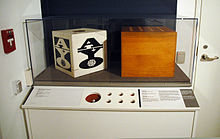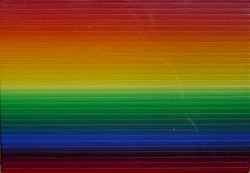Ay-O
Ay-O | |
|---|---|
| Born | Takao Iijima |
| Nationality | Japanese |
| Known for | Painter |
Ay-O (靉嘔, Aiō, Takao Iijima, 1931–) is a Japanese artist, who has been associated with Fluxus since its international beginnings in the 1960s.

Career
From Democrato to Fluxus
Probably, the best reference to understand the early years of Ay-O is the autobiographical retrospective book in the references "Ay-O, Over the Rainbow, Ay-O Restrospective 1950-2006." In a nutshell: Ay-O started his career in the Demokrato Artist Association (デモクラート美術家協会), created by Ei-Q. This association promoted artistic freedom and independence in making art. The influence of these values with Ay-O can be seen in a series of early paintings over which he painted a large X because he thought they were not original enough. Another independent movement was close to Democrato in Japan: Sōzō Biiku (創造美育) by the collector Sadajirō Kubo (久保貞次郞) promoting nurturing freedom when teaching art. Both movements started Fukui Prefecture in Japan and explain the special bound Ay-O developed with the Fukui Prefecture. Sōzō Biiku's approach is a challenge of the traditional Japanese Master-Student relationship. As such, like naive art, the movement promotes ways independent to the culturally established ones. Kubo also created the "Small Collector Society" (小コレクターの会) to spread art collection in society.
Ay-O was introduced to George Maciunas by Yoko Ono in 1961 and formally joined Maciunas in Fluxus in 1963. Ay-O was known for his Finger Boxes and for his performance events when he was active in Fluxus. He worked closely with fellow Fluxus artists Maciunas, Emmett Williams, Dick Higgins and Nam June Paik.
The Rainbow Artist
Ay-O has established a reputation in the avant gardes of Japan, Europe and the United States. In Japan, he is known as the "Rainbow Man" for his use of colorful, rainbow-striped motifs in his artwork. In its purest form some paintings are simple gradations of the Rainbow with up to 192 gradations.
Ay-O represented Japan at the Venice Biennale in 1966 and at the São Paulo Biennale in 1971. He also built the famed "Tactile Rainbow" at the Osaka World's Fair in 1970. In 1971 true to his Demokato debut he adapted 10 American Naive paintings and created a rainbow version that he called Nashville Skyline. In 1987 he did a series of Rainbow Happenings, with Rainbow Happening #17 being a 300m Rainbow Eiffel Tower project in Paris.
Recent Activities
One of his projects in English was a Collective Portrait of George Maciuanas, that he co-edited with Emmett Williams and Ann Noel. In the recent decade Ay-O has exhibited regularly at the Emily Harvey Gallery in (1996, 2001) and Gallery Itsutsuji (1996,2005,2007) and Gallery Goto (1999,2004) in Japan. In Japan Ay-O is part of the collection of the National Museum of Modern Art in Tokyo and Kyoto (see 2005 Tokyo exhibition in the links). In 2001 Ay-O had a room in the special exhibit "La fluxus Constellation" in the Museum of Contemporary Art in Genoa. He was also represented in various other Fluxus exhibitions around the world as "Centraal Fluxus Festival" Centraal Museum, Utrecht (2003), "Fluxus & Non Fluxus Fluxus" Randers kunstmuseum (2006). Ay-O was one of the "Twelve Japanese Artists from the Venice Biennale 1952-2001," in Art Tower Mito ATM, Mito. At the Mori Art Museum, Tokyo, Ay-O was part of two exhibitions: "Tokyo-Berlin / Berlin-Tokyo" in 2005 and "All about laughter" in 2007.
Fukui Retrospective
Ay-O did his most complete retrospective exhibition in the Fukui Art Museum in 2006. This exhibition was the occasion for the artist to write a bilingual book "Over the Rainbow, Ay-O Restrospective 1950-2006," in which he provides an overview of his work.
Finger boxes

The Finger Boxes are works of art by Ay-O that are the most tactile works of art in the Fluxus project. Ay-O first produced them in 1964. There are rumors that they were invented before WWII, however this is unconfirmed. It is said that all of the original Finger Boxes were destroyed during the fighting. Ay-O is said to have learned of this and claimed the invention for himself.[1] The artworks comprise largely identical hollow cubical wooden boxes with finger-sized holes in one face. As tactile works of art, it is necessary to touch them to perceive them, by placing one's finger into the hole to feel the material that is hidden within the box. The hidden contents of the boxes comprise such various things as beads, bristle brushes, hair, cotton balls, nails, and sponges.[2]
The artist's intent, by including things such as nails, which can potentially prick the finger, in the possible contents of the box is to ensure that the user touches the box with an "enquiring, learning gesture". The finger boxes are also intended to be touched by multiple people at a time, promoting a shared, social, experience of perceiving the work.[3]
Several versions of the Finger Box exist, including one set of boxes in a briefcase (entitled Finger Box (valise edition)) which is in the Gilbert and Lila Silverman Fluxus Collection in Detroit, and a version (included in Fluxus I) that uses sealed envelopes that have been slit open instead of boxes.[4]
Publications
- Mr. Fluxus: A Collective Portrait of George Maciunas 1931-1978, Thames & Hudson, 1998
- Niji: Ai O hanga zen sakuhinshu, 1954–1979, Published in English by Sobunsha
- Ouzel, Chikumasyobo Publishing, 1978
- Ay-O, Over the Rainbow, Ay-O Restrospective 1950-2006 (174 pages) (ISBN 4568103592), Bijutsu Shuppan-Sha (ja:美術出版社), 2006
References
- ^ Higgins 2002, p. 38.
- ^ Higgins 2002, p. 39.
- ^ Higgins 2002, p. 39–40.
- ^ Higgins 2002, p. 38–40.
- Rainbow Rainbow prints, Catalogue raisonne, Abe Shuppan, Co, 2000
- Japan Quarterly, Asahi Shinbunsha eds, 1973,v. 20 p187 and v.22-23 1975-1976 p286
- Caroline Parsons, People the Japanese Know, Japan Times eds, 127 pages (ISBN 4789004538), 1989
- Leigh Landy, Technology, Avant Garde collection (Interdisciplinary and International Series) (ISBN 9051832869), p 23, 1992
- Higgins, Hannah (2002). Fluxus experience. ISBN 978-0-520-22867-2.
{{cite book}}: Invalid|ref=harv(help) - Owen Smith, Fluxus: The History of an Attitude, San Diego State University Press, 1999
- Midori Yoshimoto Into Performance: Japanese Women Artists In New York, p41 and p118 (ISBN 0813535212), Rutgers University Press, 2005
External links
- Ay-O at Emily Harvey Gallery
- Ay-O at the Tokyo MOT
- Rainbow Manifesto by Ay-O
- Tokyo Fluxus
- "The New Japan" by David Elliott
- Ay-O in the Fluxus Archives, includes work examples
- The Fluxus Constellation
- Twelve Japanese Artists from the Venice Biennale 1952-2001
- Fukuoka Museum
- Fluxus: Art in Life, Urawa Art Museum [1]
- "Fluxus, Non-Fluxus", Randers Kunstmuseum
- 2006 retrospective at the Fukui museum

